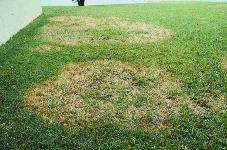
by Sheila Dunning | Mar 31, 2022
 As the temperatures warm into the 70’s and the rain chance remains good, keep an eye open for disease in your lawn. Large patch disease is common in turfgrass this time of the year. It is caused by the fungus Rhizoctonia solani. The fungus is present in the soil and thatch layer year-round. When the temperatures rise into the 60’s and 70’s it begins to spread. Large patch thrives under these conditions, especially when the soil is wet. With frequent showers the disease spreads quickly. The first symptom of large patch is circular, discolored areas within the lawn. The outer borders of the patches are orange to yellowish in color. In the center of the circle there are grass blades trying to green up again. They are usually unsuccessful, resulting in odd-shaped patches of dying grass that begin to connect to each other. A simple field diagnostic techniques to confirm large patch disease is to pull on the diseased grass shoots near the edge of the circle. The blades will come loose from the stolon easily. At the base of the leaves the stem and sheaths will appear dark brown and rotten. Yes, it is large patch.
As the temperatures warm into the 70’s and the rain chance remains good, keep an eye open for disease in your lawn. Large patch disease is common in turfgrass this time of the year. It is caused by the fungus Rhizoctonia solani. The fungus is present in the soil and thatch layer year-round. When the temperatures rise into the 60’s and 70’s it begins to spread. Large patch thrives under these conditions, especially when the soil is wet. With frequent showers the disease spreads quickly. The first symptom of large patch is circular, discolored areas within the lawn. The outer borders of the patches are orange to yellowish in color. In the center of the circle there are grass blades trying to green up again. They are usually unsuccessful, resulting in odd-shaped patches of dying grass that begin to connect to each other. A simple field diagnostic techniques to confirm large patch disease is to pull on the diseased grass shoots near the edge of the circle. The blades will come loose from the stolon easily. At the base of the leaves the stem and sheaths will appear dark brown and rotten. Yes, it is large patch. 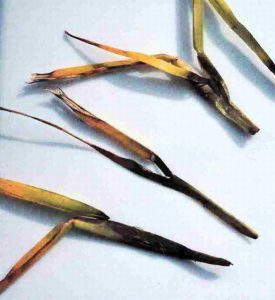 If the weather gets colder or hotter very quickly, the disease will go back into dormancy. Looking at the long range temperature predictions, cool night and warm days are likely to continue for awhile. So, start looking for a fungicide or two or contact your pest control service. However, remember fungicides don’t cure existing problems. They are utilized as a protectant for the unaffected portions of the grass. When favorable conditions are present, the turf should be sprayed in order to keep the fungus from penetrating the grass blades. Repeat applications will be needed for as long as the weather is cool and wet. Check the product label for the correct intervals. Several cultural practices promote large patch infection including over-fertilization, over-irrigation, low mowing height, poor drainage and excess thatch. This spring after the grass has greened-up on its own is a good time to look at these factors and make corrections. Keep a close eye because as soon as the temperatures drop again in the fall, large patch can reappear if the corrections were not complete. For more information: https://edis.ifas.ufl.edu/lh044
If the weather gets colder or hotter very quickly, the disease will go back into dormancy. Looking at the long range temperature predictions, cool night and warm days are likely to continue for awhile. So, start looking for a fungicide or two or contact your pest control service. However, remember fungicides don’t cure existing problems. They are utilized as a protectant for the unaffected portions of the grass. When favorable conditions are present, the turf should be sprayed in order to keep the fungus from penetrating the grass blades. Repeat applications will be needed for as long as the weather is cool and wet. Check the product label for the correct intervals. Several cultural practices promote large patch infection including over-fertilization, over-irrigation, low mowing height, poor drainage and excess thatch. This spring after the grass has greened-up on its own is a good time to look at these factors and make corrections. Keep a close eye because as soon as the temperatures drop again in the fall, large patch can reappear if the corrections were not complete. For more information: https://edis.ifas.ufl.edu/lh044
The Institute of Food and Agricultural Sciences (IFAS) is an Equal Opportunity Institution authorized to provide research, educational information and other services only to individuals and institutions that function with non-discrimination with respect to race, creed, color, religion, age, disability, sex, sexual orientation, marital status, national origin, political opinions or affiliations. For more information on obtaining other extension publications, contact your county Cooperative Extension service.
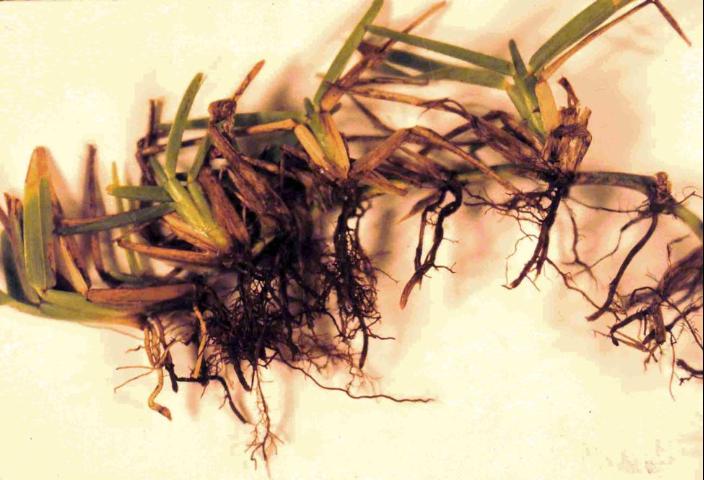
by Blake Thaxton | Sep 29, 2016

St. Augustinegrass roots rotted due to take-all root rot. (Photo Credit: IFAS Photos)
The crisp air of fall is upon us. Maybe. We live in northwest Florida and we are not experiencing the change in weather just yet. With the change in weather coming, we are having specific issues in turfgrass lawns and are sure to have others in the near future. Extension agents in the western panhandle have come into contact with several St. Augustine lawns with symptoms and signs of take-all root rot (Gaeumannomyces graminis var. graminis) and we can soon expect with cooler temperatures for Large Patch to be rearing its ugly head.

Early aboveground symptoms of take-all root rot. (Photo Credit: IFAS Photos)
Take-all root rot is sometimes referred to as a “stress disease”, as it is brought on by stressful weather conditions and improper management. Periods of rainfall can provide conditions for the disease to affect all warm season grasses. Other stresses such as improper mowing height, improper irrigation, and improper fertilization can worsen the situation. For example, St. Augustinegrass, except dwarf cultivars, should be mowed at 3.5 to 4 inches and the mower should never remove more than 1/3 of the leaf blade at any cutting. With the current high temperatures and prolonged periods of rainfall it can be difficult to follow this practice. When a homeowner does not mow the lawn in a timely manner and lets the lawn grass get much too high and cuts more than 1/3 of the grass blade, this can become a stress to the lawn. Fungicide sprays can be made during favorable environmental conditions, before symptoms are seen to protect from infection with take-all root rot for high valued properties. To learn more about take-all root rot refer to this University of Florida/IFAS Extension publication: Take-all Root Rot
With the fall weather coming, please be sure to read and learn about large patch disease as well. This can brought on by temperatures of less than 80 degrees and high humidity or extended periods of rainfall. Read the University of Florida/IFAS Extension publication for more information: Large Patch
For any other information needed regarding proper lawn management, please visit Your Florida Lawn or contact your local UF/IFAS Extension office.
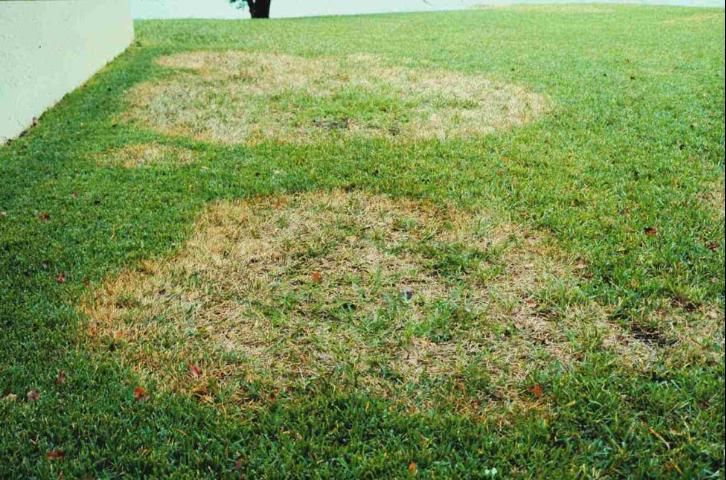
by Blake Thaxton | Sep 16, 2015

Brown patch symptoms on St. Augustinegrass.
Credit: M. L. Elliott
Beautiful weather and pleasant cool temperatures have made their way into the Florida panhandle in the last week. They will not stay long. It will be scorching hot again this year before the relief of fall settles in for good. As nice as the weather has been, it could cause problems for lawns in the panhandle. Temperatures below 80° F with moisture from rainfall can be a trigger for Brown Patch, also known as Large Patch.
The disease damages the turf by rotting the lower portion of the grass blade. When inspected closely and smelled, Brown Patch has a rotted odor associated. The disease does not affect the roots of the grass but will totally rot the base of the leaf and eventually kill the entire leaf. Patches generally die out in a 1 foot diameter area and move out from there.
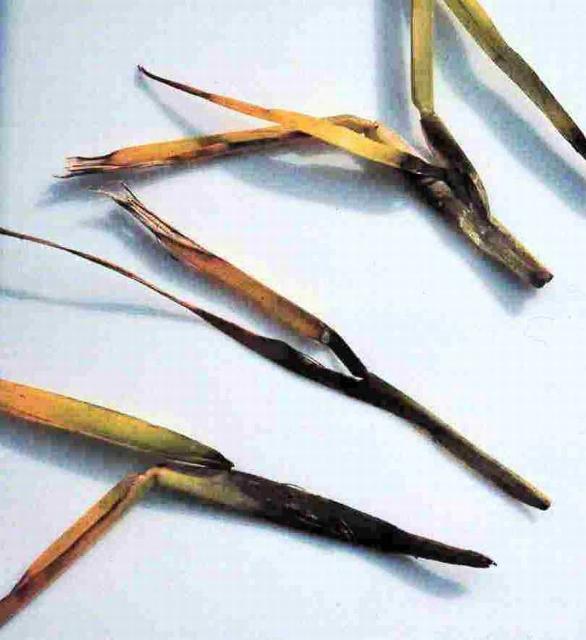
Base of leaf is rotted due to brown patch.
Credit: UF/IFAS photos
Some homeowners apply a fall application of fertilizer this time of year to “winterize” their lawns. Excess nitrogen can exacerbate the problem during times of favorable conditions. Many of the “winterizer” fertilizer on the market have a high percentage of nitrogen; so avoid these fertilizers this time of year. Choose a fertilizer with little to no nitrogen but a high percentage of potassium to encourage strong root growth headed into winter.
For more information regarding the disease, read this University of Florida/IFAS publication: Large Patch by M. L. Elliott and P. F. Harmon

 As the temperatures warm into the 70’s and the rain chance remains good, keep an eye open for disease in your lawn. Large patch disease is common in turfgrass this time of the year. It is caused by the fungus Rhizoctonia solani. The fungus is present in the soil and thatch layer year-round. When the temperatures rise into the 60’s and 70’s it begins to spread. Large patch thrives under these conditions, especially when the soil is wet. With frequent showers the disease spreads quickly. The first symptom of large patch is circular, discolored areas within the lawn. The outer borders of the patches are orange to yellowish in color. In the center of the circle there are grass blades trying to green up again. They are usually unsuccessful, resulting in odd-shaped patches of dying grass that begin to connect to each other. A simple field diagnostic techniques to confirm large patch disease is to pull on the diseased grass shoots near the edge of the circle. The blades will come loose from the stolon easily. At the base of the leaves the stem and sheaths will appear dark brown and rotten. Yes, it is large patch.
As the temperatures warm into the 70’s and the rain chance remains good, keep an eye open for disease in your lawn. Large patch disease is common in turfgrass this time of the year. It is caused by the fungus Rhizoctonia solani. The fungus is present in the soil and thatch layer year-round. When the temperatures rise into the 60’s and 70’s it begins to spread. Large patch thrives under these conditions, especially when the soil is wet. With frequent showers the disease spreads quickly. The first symptom of large patch is circular, discolored areas within the lawn. The outer borders of the patches are orange to yellowish in color. In the center of the circle there are grass blades trying to green up again. They are usually unsuccessful, resulting in odd-shaped patches of dying grass that begin to connect to each other. A simple field diagnostic techniques to confirm large patch disease is to pull on the diseased grass shoots near the edge of the circle. The blades will come loose from the stolon easily. At the base of the leaves the stem and sheaths will appear dark brown and rotten. Yes, it is large patch.  If the weather gets colder or hotter very quickly, the disease will go back into dormancy. Looking at the long range temperature predictions, cool night and warm days are likely to continue for awhile. So, start looking for a fungicide or two or contact your pest control service. However, remember fungicides don’t cure existing problems. They are utilized as a protectant for the unaffected portions of the grass. When favorable conditions are present, the turf should be sprayed in order to keep the fungus from penetrating the grass blades. Repeat applications will be needed for as long as the weather is cool and wet. Check the product label for the correct intervals. Several cultural practices promote large patch infection including over-fertilization, over-irrigation, low mowing height, poor drainage and excess thatch. This spring after the grass has greened-up on its own is a good time to look at these factors and make corrections. Keep a close eye because as soon as the temperatures drop again in the fall, large patch can reappear if the corrections were not complete. For more information: https://edis.ifas.ufl.edu/lh044
If the weather gets colder or hotter very quickly, the disease will go back into dormancy. Looking at the long range temperature predictions, cool night and warm days are likely to continue for awhile. So, start looking for a fungicide or two or contact your pest control service. However, remember fungicides don’t cure existing problems. They are utilized as a protectant for the unaffected portions of the grass. When favorable conditions are present, the turf should be sprayed in order to keep the fungus from penetrating the grass blades. Repeat applications will be needed for as long as the weather is cool and wet. Check the product label for the correct intervals. Several cultural practices promote large patch infection including over-fertilization, over-irrigation, low mowing height, poor drainage and excess thatch. This spring after the grass has greened-up on its own is a good time to look at these factors and make corrections. Keep a close eye because as soon as the temperatures drop again in the fall, large patch can reappear if the corrections were not complete. For more information: https://edis.ifas.ufl.edu/lh044


